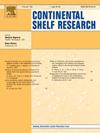调查海底地下水通过冰川变质粘土排入波罗的海的情况
IF 2.1
3区 地球科学
Q2 OCEANOGRAPHY
引用次数: 0
摘要
海底地下水排放(SGD)是将陆地溶解的化学物质输送到沿岸海洋的一个重要过程,从而对海洋生态系统产生影响。尽管 SGD 非常重要,但针对波罗的海北部 SGD 的研究却很少。在此,我们调查了斯德哥尔摩群岛南部 Fifång 岛周围一个以冰川粘土变异形成的海底阶地为特征的区域可能出现的 SGD。我们分析了从 Fifång 岛及其周边近海区域取回的海洋和陆地沉积物岩芯中的 222Rn 活性和孔隙水地球化学。222Rn 质量平衡计算、水同位素、盐度、氯化物浓度和年代测定(包括 14C 和氦-氚年代测定)的结果表明,现代地下水流经菲佛昂岛上的变异冰川粘土层和断裂岩石,然后排入菲佛昂海湾。此外,近海岩芯还揭示了一个含盐地下水源,根据溶解无机碳的年代测定,该地下水源似乎比使用瑞典粘土岩层年代测定法测定的寄居粘土岩层年代要年轻。我们获得的海底剖面中的声学空白可能与这种流体迁移有关。这种含盐地下水的出现似乎与海底阶地的距离无关。总之,我们的研究证实,在靠近菲佛昂岛和离岸更远的地方,冰川粘土变质层中存在海底地下水。我们的研究结果有助于确定海底地下水排放对波罗的海地区过去和现在沿海环境的重要影响。本文章由计算机程序翻译,如有差异,请以英文原文为准。
Investigation of submarine groundwater discharge into the Baltic Sea through varved glacial clays
Submarine groundwater discharge (SGD) is an important process responsible for transporting terrestrial dissolved chemical substances into the coastal ocean, thereby impacting the marine ecosystem. Despites its significance, there are few studies addressing SGD in the northern Baltic Sea. Here we investigate the potential occurrence of SGD in an area characterized by seafloor terraces formed in varved glacial clay located around Fifång Island, Southern Stockholm Archipelago. We analyzed 222Rn activity and porewater geochemistry in both marine and terrestrial sediment cores retrieved from Fifång Island and its surrounding offshore areas. Results from 222Rn mass-balance calculations, water isotopes, salinity, chloride concentration, and dating (including 14C and helium-tritium dating) indicate that modern groundwater flows through varved glacial clay layers and fractured rocks on Fifång Island and discharges into Fifång Bay. Additionally, the offshore cores reveal a saline groundwater source that, dating of the dissolved inorganic carbon, appears systematically younger than the hosting clay varves dated using the Swedish clay varve chronology. Acoustic blanking in our acquired sub-bottom profiles may be related to this fluid migration. The occurrence of this saline groundwater seems to be independent from the distance to the submarine terraces. Collectively, our study confirms the occurrence of submarine groundwater in the varved glacial clay close to Fifång Island and further offshore. Our findings help establish the significance of submarine groundwater discharge in influencing the past and present coastal environment in the Baltic Sea region.
求助全文
通过发布文献求助,成功后即可免费获取论文全文。
去求助
来源期刊

Continental Shelf Research
地学-海洋学
CiteScore
4.30
自引率
4.30%
发文量
136
审稿时长
6.1 months
期刊介绍:
Continental Shelf Research publishes articles dealing with the biological, chemical, geological and physical oceanography of the shallow marine environment, from coastal and estuarine waters out to the shelf break. The continental shelf is a critical environment within the land-ocean continuum, and many processes, functions and problems in the continental shelf are driven by terrestrial inputs transported through the rivers and estuaries to the coastal and continental shelf areas. Manuscripts that deal with these topics must make a clear link to the continental shelf. Examples of research areas include:
Physical sedimentology and geomorphology
Geochemistry of the coastal ocean (inorganic and organic)
Marine environment and anthropogenic effects
Interaction of physical dynamics with natural and manmade shoreline features
Benthic, phytoplankton and zooplankton ecology
Coastal water and sediment quality, and ecosystem health
Benthic-pelagic coupling (physical and biogeochemical)
Interactions between physical dynamics (waves, currents, mixing, etc.) and biogeochemical cycles
Estuarine, coastal and shelf sea modelling and process studies.
 求助内容:
求助内容: 应助结果提醒方式:
应助结果提醒方式:


